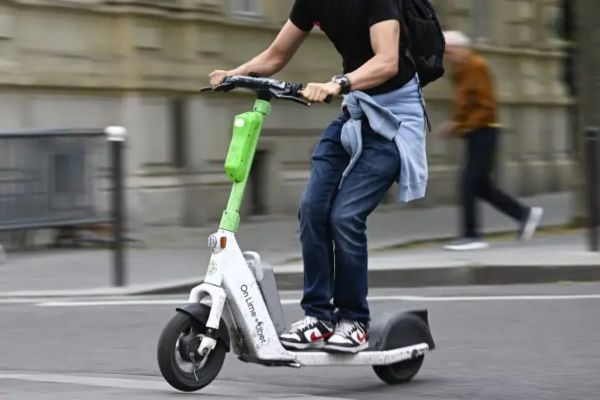In today’s fast-paced urban world, electric scooters are widely adopted for their cost-efficiency and eco-friendly convenience. Yet even the most efficient scooter can be grounded by a single flat tire. For safety-conscious and time-sensitive riders, that inconvenience can turn into a full-blown disruption.
Flat repairs often cost around $50, take time and effort, and sometimes require walking the final mile. Past efforts to use sealants or patch kits still led many users to abandon pneumatic options altogether. For commuters who prioritize absolutely reliable, maintenance-free performance, scooters with solid, airless tires offer the clearest solution.
Best Electric Scooters With Solid Tires
Four scooters fully matched the requirement of having solid, honeycomb airless tires, each from different brands, featuring various strengths and compromises. Below is an in-depth look at each.
| Model | Tire + Suspension | Real Range Estimate | Weight & Build | Best Match For |
| Unagi Voyager | 7.5″ honeycomb, no suspension | ~9–12 miles | ≈ 29 lbs, premium aesthetic | Riders prioritizing ultra-light design on smooth terrain |
| Hiboy S2 Pro | 10″ honeycomb with rear springs | ~12–14 miles at top speed | ≈ 36 lbs, robust brand | Daily commuters need rugged reliability and ride softness |
| iSinwheel S9 Max | 10″ honeycomb with dual springs | ~14–18 miles | ≈ 34 lbs, specs-rich but inconsistent | Budget riders are comfortable managing DIY upkeep |
| iENYRID M1 | 10″ honeycomb with front fork | ~15–18 miles | ≈ 33 lbs, low trust | Short-term or budget-limited riders accepting risk |
Unagi Model One Voyager
Focused on elegance and portability, the Voyager weighs less than 30 pounds and uses premium materials like carbon fiber and magnesium alloy. Equipped with dual 250 W motors delivering up to 1,000 W peak power, it promises speeds up to 20 mph and a claimed 25-mile range.
Its vented 7.5-inch honeycomb tires eliminate flat risks and rely entirely on internal cushion rather than mechanical suspension. Without any shock absorbers, the ride becomes drastically harsher over even minor bumps.
Real-world range often drops to under half of the advertised figure, closer to 9–12 miles at full power. While its folding mechanism and aesthetics are consistently lauded, riders describe the ride as uncomfortably stiff, sometimes even dangerous, on typical city streets. Unless your route consists almost exclusively of flawless pavement, Unagi’s design compromises comfort for style and portability.
Check PriceHiboy S2 Pro
The S2 Pro represents the best balance between reliability and ride comfort. This model uses larger 10-inch honeycomb solid tires paired with dual rear spring suspension. Its motor is rated at 500 W nominal, with 750 W peak output, producing speeds up to 19 mph. User tests reveal a more realistic range of around 12–14 miles at higher speeds, slightly more at lower speeds.
User feedback highlights responsive braking with both mechanical disc and regenerative systems, app connectivity, cruise control, and robust build quality. The ride is significantly smoother than suspension-less options, though still firmer than pneumatic scooters. Weighing 36.3 pounds, it trades off portability for comfort and stability. As a reputable mid‑tier brand, Hiboy offers reliable components, real-world usability, and strong support. It delivers an ideal mix for riders who want their travels to remain flat-free, comfortable, and dependable.
Check PriceiSinwheel S9 Max
This scooter arrives with spec-heavy features for its price: 10-inch honeycomb solid tires, dual spring suspension both front and rear, and a 500 W motor topping around 21 mph. The battery system claims a 22-mile range. With app support, dual braking systems, and dual suspension, the S9 Max is designed to impress specs-driven buyers.
However, user data shows inconsistent component quality. Reports include stripped brake components, worn tires after a few hundred miles, stiff suspension that fails to provide real comfort, and poor customer service. Despite the attractive price and specs, the long-term ride experience varies. For riders comfortable tinkering, accepting repairs, and making upgrades, it may be a compelling budget choice. For commuters needing reliable, maintenance-light service, less so.
Check PriceiENYRID M1
The iENYRID M1 offers flat-free travel on a tight budget, using 10-inch honeycomb tires and front fork suspension only. Claims include a top speed up to 22 mph and a flexible range of 15–22 miles depending on speed and terrain.
Yet buyer reports describe a wide variation in construction quality. Many consider it a “generic parts-bin” scooter, prone to early component failures, slow support, and difficulty sourcing replacements. While its low weight (33 pounds) and feature set, like turn signals and app control, are compelling, long-term reliability is questionable. It suits occasional riders or experimental users, not someone who relies on their scooter daily.
Check PriceTailored Recommendations Based on Rider Goals
Your ideal scooter depends on the balance of your priorities:
- For consistent, daily commuting with minimal worry, the Hiboy S2 Pro stands out. Its 10-inch airless setup, real suspension, and reliable build give you confidence in nearly any city environment, without the worry of tire flats.
- If elegance, light weight, and portability matter most and you ride on exceptionally well-maintained pavement, the Unagi Model One Voyager delivers premium design and compactness,but you must accept a jarring ride.
- If you want maximum features for minimal cost, and you’re comfortable with tinkering and maintenance, the iSinwheel S9 Max offers strong on-paper value. But be ready for possible parts issues and inconsistent support.
- The iENYRID M1 is best for riders on tight budgets seeking flat immunity. However, it is not a long-term reliable choice and is best suited for short-term use or experimentation.
Why Puncture‑Proof Tires Are More Than Just a Convenience
An unexpected flat tire can turn a seamless commute into a stressful inconvenience. Riders have described replacing scooter tires after hundreds of miles, only to suffer repeated flats that undermined both their routine and their savings. Sealants and plugs offer inconsistent protection, especially when small embedded debris continues puncturing new tires.
Consequently, many commuters choose to sacrifice cushioning in exchange for guaranteed mobility. Solid tires offer that reliability: they simply do not go flat, eliminating the need for constant maintenance, patch kits, or found replacement vendors. For a daily urban rider, that assurance can outweigh the comfort benefits of air-filled designs.
The Tires You Want to Avoid, or Accept: Comfort vs. Resilience
To evaluate any solid‑tire scooter, you must weigh a host of engineering trade‑offs. Traditional pneumatic tires offer superior cushioning, traction, and ride quality. They flex under load to conform to the road’s irregularities, helping with braking and control. Yet they are vulnerable to puncture from glass, nails, and gravel, and require regular air pressure checks and occasional repair.
Solid tires, in contrast, eliminate flat risks entirely. But by their nature, they offer no air cushion, so comfort and grip suffer. They often transmit every bump or crack to the rider’s hands or feet, increasing fatigue and reducing control, especially in wet or slick conditions. Solid tires are heavier, reducing portability and possibly shortening battery range. But newer designs, such as honeycomb-patterned or foam-filled airless tires, attempt to soften the harsher edge while preserving flat-proof integrity.
Engineers often combine solid tire design with mechanical suspension to offset discomfort. A well-executed suspension system can dramatically improve ride quality; without it, even advanced solid tire designs will feel punishing on anything less than perfect pavement.
Variants of Airless Tire Technology: Rubber, Honeycomb, and Foam
Solid-tire scooters employ one of three key design types. Solid rubber tires are simply heavy blocks of rubber with zero cushioning. Most economical scooters use them, but rider feedback consistently flags ride harshness.
Honeycomb or vented solid tires contain a lattice of hollow structures inside the rubber casing. These internal pockets compress under weight, offering a limited cushioning effect that approximates pneumatic comfort. They strike the best balance between durability, weight, and ride quality in today’s flat-proof market.
Foam-filled casings provide another alternative: a foam core within a tire shell replicates cushioning while eliminating punctures. These are less common in scooters, but offer solid ride comfort paired with flat immunity, though still not as responsive as properly pressured pneumatic tires.
Reflecting on the Trade-Offs: What Solid Tires Really Mean
Solid-tire tech addresses reliability head-on, yet comfort, traction, and control remain compromised. The best solutions involve thoughtful hardware pairing: honeycomb construction, robust suspension, and solid braking systems. Weight and portability will always remain secondary to durability in this segment.
Ideally, self-sealing pneumatic tires will become a standardized technology, offering flat resistance alongside comfort at scale. Until then, riders must choose: solid, dependable, and rough, or comfortable, ephemeral, and risky. Among current options, the Hiboy S2 Pro offers the most intelligent compromise, combining flat-free design with real-world usability.
Conclusion: Balancing Reliability and Comfort in Solid-Tire Electric Scooters
Choosing the right electric scooter with solid tires is ultimately a matter of balancing reliability, ride comfort, and personal priorities. Solid tires provide an unbeatable advantage by eliminating flats and the maintenance headaches that come with pneumatic tires. This reliability is a crucial benefit for urban commuters who depend on their scooters daily and cannot afford unexpected breakdowns or costly repairs.
However, this durability comes with trade-offs. Solid tires, especially the smaller and simpler solid rubber types, deliver a much harsher ride. Without the natural cushioning of air-filled tires, bumps and vibrations are transmitted directly to the rider, increasing fatigue and reducing overall comfort. This challenge has led manufacturers to innovate with honeycomb and foam-filled designs that soften the ride, though they still cannot fully replicate pneumatic performance.
Another key factor is the scooter’s suspension system. Since solid tires absorb little shock, a good suspension is essential to improve ride quality. Models like the Hiboy S2 Pro, with rear suspension paired with larger 10-inch honeycomb tires, strike a practical balance, offering dependable flat protection without sacrificing too much comfort. On the other hand, ultra-light scooters like the Unagi Voyager prioritize portability and style but deliver a much rougher ride due to their small, solid tires and lack of suspension.
Budget options such as the iSinwheel S9 Max and iENYRID M1 demonstrate that affordable flat-proof scooters exist, but buyers must be cautious about long-term reliability and component quality.
Looking ahead, the future of reliable urban scooters may lie in emerging technologies like self-sealing pneumatic tires, which promise the comfort of air-filled tires with greatly reduced flat risks.
For now, riders must carefully consider their daily routes, weight preferences, and tolerance for road vibrations. The best solid-tire scooter is one that aligns with your specific commuting needs, offering the right blend of durability, ride comfort, and value. This thoughtful balance ensures you get the freedom of a flat-free ride without sacrificing your everyday comfort and control.




